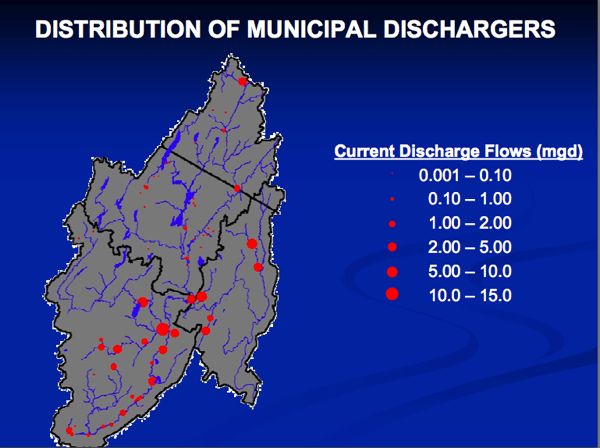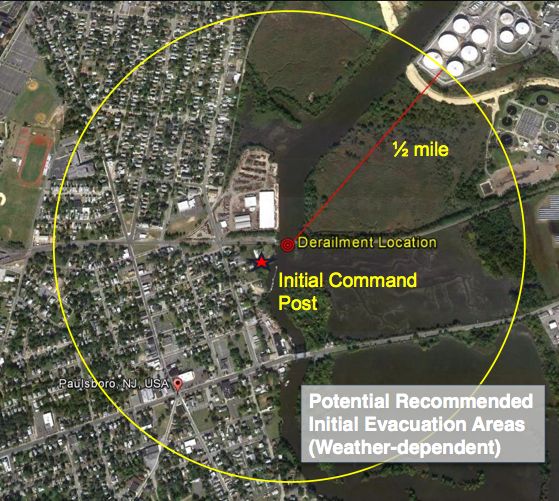NJ’s Little Known But Massive Wastewater Recycling Water Supply Project
Passaic Basin Provides 475 Million Gallons Per Day of Mostly Treated Sewage For NJ Water Supply
NJ DEP Silent On or Misleading Public About A Controversial Practice
My trip to California got me thinking about the epic drought there and the various mitigation strategies being considered, including the reuse of wastewater.
Reuse of treated wastewater (e.g. the discharge from sewage treatment plants) is a controversial topic, even for relatively minor uses, like irrigation of golf courses or non-food crops.
The concept of using treated sewage for public water supply is virtually an unspoken taboo.
So, I thought readers would be interested in exploring the implications of the fact that NJ, for decades, has relied on a massive wastewater reuse project – for drinking water – in the Passaic Basin, including the Ramapo, Pompton, and Passaic Rivers.
During dry periods and summer months, the flows of those river are dominated by wastewater discharges – at times over 90% of the rivers’ flow comes from wastewater treatment plants. The water supply infrastructure is designed to rely on wastewater discharge.
And the Passaic Basin is not the only place where NJ residents are drinking million of gallons a day of treated sewage.
Water supply intakes located on the Delaware and Raritan rivers, among others, also rely on significant flows of treated wastewater.
But, you would not know any of that by listening to Highlands advocates or by reading NJ DEP’s “wastewater reuse” webpage, which explicitly claims that reuse is limited to “non-potable applications”:
Over the past few years, the Division of Water Quality Reclaimed Water for Beneficial Reuse Task Force has been working to promote and implement the beneficial reuse of wastewater from domestic and industrial wastewater dischargers. RWBR involves taking what was once considered waste, giving it specialized treatment, if necessary, and using it for public and/or restricted access uses. This high quality reclaimed water can be used for non-potable applications in place of potable water or as a supplement to potable water. RWBR has a myriad of application potentials including the spray irrigation of crops, parks, and golf courses; dust control; fire fighting; and toilet flushing, to list a few. The high-level of disinfection and effluent treatment required for RWBR protects public health and environmental quality.
Does discharge and dilution of wastewater in a river alter the fact that the wastewater is “recycled” or “reclaimed” and “reused” at downriver water supply intakes? Even when wastewater is 50% or more of river flow? 90%?
Perhaps if DEP released the long overdue Update of the NJ Waster Supply Master Plan, we could have a public discussion about these controversial practices.
That discussion would include whether we should upgrade wastewater treatment technology to protect drinking water intakes, instead of weakening surface water quality standards as DEP is currently considering, as NJ Spotlight recently reported:
Bill Wolfe, New Jersey director of Public Employees for Environmental Responsibility (NJPEER), said the DEP’s proposed new approach fails to consider the ecological impacts of nitrogen on waterways.
“It ignores longstanding historical policy of ‘source water protection’ — that the policy burden on the wastewater dischargers is to protect water supplies — and shifts quite a bit of the cost and compliance burden onto the water purveyors,’’ Wolfe said.
In the Passaic River, there are 72 sewage plants discharging into the waterway, which supplies potable water to millions of customers in the region, according to Tittel. In the Raritan River, there are 60 such plants discharging into the river, also a major source of drinking water, he said.
That discussion would also include whether we should upgrade drinking water treatment technology given the large amount of wastewater discharged to water supply rivers and the hundreds of unregulated chemicals detected in these rivers we rely on to provide drinking water supply.
Trenton — New Jersey should filter its drinking water to remove hundreds of chemicals, most of which are unregulated, from its drinking water supply, according to a rulemaking petition filed today by Public Employees for Environmental Responsibility (PEER). The plan to screen many chemicals out of tap water was actually developed by the state Department of Environmental Protection (DEP) but has been in limbo for the last six years.
State testing has detected “approximately 600” chemical compounds “in 199 samples collected” including five brands of bottled water, according to a recent DEP white paper. The vast majority of these chemicals, including pharmaceuticals, hormones, and cleaning products, are not regulated by either the federal or state government. As a result, there is no regulatory effort to reduce or eliminate them from drinking water.
The April 2010 DEP white paper, entitled “Investigations Related to a ‘Treatment-Based’ Regulatory Approach to Address Unregulated Contaminants in Drinking Water,” advocates used granular activated carbon filtration and other techniques to remove most chemicals in drinking water, noting that carbon filtration alone removed more than half of identified chemicals.
The discussion also might consider not only the serious adverse health effects of these largely unregulated chemicals on people, but on fish and wildlife, particularly in light of recent news reports of “intersex fish” in the Delaware River.
[Update: It would also discuss the need to expand protections for stream buffers to control non-point source pollution and storm water runoff by C1 designations.]
- Reuse of wastewater for drinking water in the Passaic Basin
But let’s get back to the topic of this post, which is the effective reuse of wastewater for drinking water.
According to the DEP TMDL Non-Tidal Passaic River Basin, which was designed to protect the Wanaque Reservoir:
At the confluence of the Pompton and Passaic Rivers, the Wanaque South intake diverts water into the Wanaque Reservoir. Water diverted at this location can, depending on pumping relative to stream flows, include both the Pompton and Passaic Rivers. As a result, phosphorus loads from both waterbodies can be directed to the reservoir, where they accumulate and cycle within the impoundment creating the opportunity for excessive primary productivity over the growing season. High levels of chlorophyll-a have been observed in the Wanaque Reservoir, although measured levels are lower than they would be naturally due to physical and chemical control measures exercised by NJDWSC.
To maintain this yield, the Wanaque Reservoir utilizes inflows from three separate sources: (1) its natural tributary system, which includes the Monksville Reservoir; (2) the Pompton Lakes intake, which is located on the Ramapo River; and (3) the Two Bridges intake, which is located on the Pompton River about 750 feet upstream from the confluence with the Passaic River. The NJDWSC has the capability of pumping up to 150 mgd from the Pompton Lakes intake, and up to 250 mgd from the Two Bridges intake. By design, when the diversion from the Two Bridges intake exceeds the available flow in the Pompton River, this intake has the ability to reverse flows in the lowermost reach of the Pompton River and tap the locally impounded waters of the Passaic River. Thus, the entire upper Passaic watershed (with a drainage area of 361 square miles) becomes a contributing source to the Reservoir. To maintain water quality and protect users in the downstream portions of the Passaic, Pompton and Ramapo Rivers, the Department has implemented several restrictions on intake usage, including:
(a) no diversions during July and August unless there is a declared drought emergency; (b) no diversions from the Pompton Lakes intake when flows in the Ramapo River are below 40 mgd; and (c) no diversions when flows in the Passaic River at Little Falls are below 17.6 mgd (modified from Najarian (2005)
- Passaic Valley Water Supply Intake
But the pumping of polluted river water to the Wanaque Reservoir is not the only reuse of wastewater in the Passaic Basin.
According to the Passaic Valley Water Commission
The current plant, operated by the Passaic Valley Water Commission, delivers approximately 60 million gallons per day of Passaic and Pompton River water to a population of more than 750,000. […]
The Little Falls plant is now the largest ballasted flocculation plant in North America. With a capacity upgrade from 75 MGD to 120 MGD
So there it is.
NJ residents are drinking almost 500 million gallons per day of treated wastewater.
So, I put the questions to those folks:
- Should DEP be strengthening water quality standards and regulating more chemicals to protect your drinking water?
- Should DEP be requiring that wastewater plants upgrade their treatment technology to remove more chemical pollutants?
- Should DEP be requiring that drinking water plants install state of the art activated carbon treatment technology to remove unregulated chemicals?
- How much are you willing to pay for safe and clean drinking water?
Gov. Christie’s DEP Commissioner wants to provide “regulatory relief” to those drinking water and sewage treatment plants – what do you think about that?
Let the Gov. and your legislator know.


